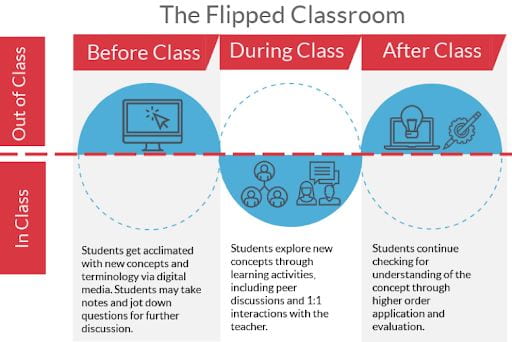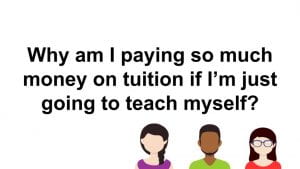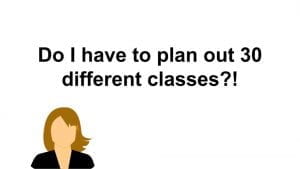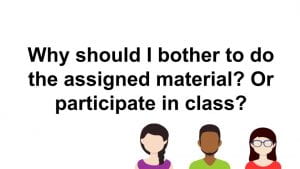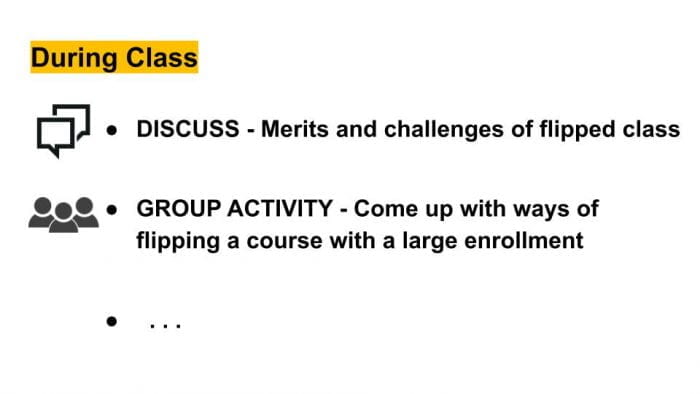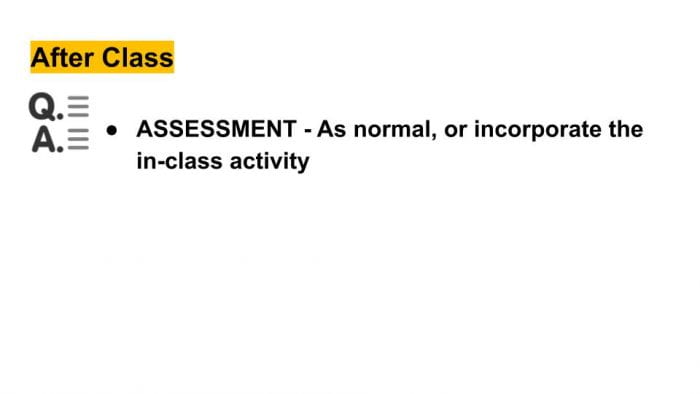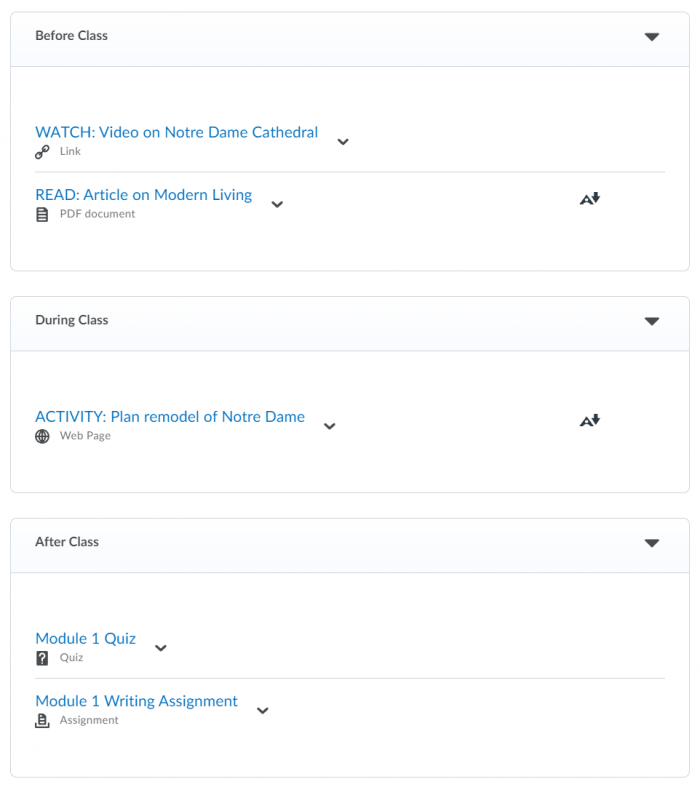Flipped Classroom. A Definition
“A flipped classroom is an instructional strategy and a type of blended learning, which aims to increase student engagement and learning by having students complete readings at their home and work on live problem-solving during class time” (Wikipedia Contributors, 2021).
This graphic visually represents the flipped classroom, where scheduled class time is spent on learning activities, not on content delivery.
This is accomplished with the use of “before” and “after” class” components.
Why do we Flip our classroom?
To foster more active learning and experimentation during class. Our goal is to replace lecture-style platforms by incorporating technology and rich media to enable students to learn in ways they would not be able to on a strictly physical campus.
Critical Thinking
A flipped classroom hosts higher-order thinking than the traditional model. This graphic shows Bloom’s Taxonomy, where the higher up on the pyramid represents more critical thinking. In a flipped classroom, these more complex levels are done during class, with the instructor there as a “guide on the side”.
Downsides
Be forewarned, there are major cons of a flipped classroom! For starters, it relies on preparation and trust. It requires a significant amount of work on the front-end. Not to mention it increases the time in front of screens. Something that none of us need, and at worst can exacerbate a digital divide.
Upsides
A flipped classroom has to power to promote student-centered learning and collaboration. It potentially could solve the problems related to unengaged or bored students. And it could foster accessible lessons and content that can increase the efficiency of the lesson. In summary, a flipped classroom has the potential to be transformative!
Best Practices
Knowing that this technique has a fairly equal number of pros and cons, here are some best practices to help you think the practice through.
Why am I paying so much money on tuition if I’m just going to teach myself?
This is a common response from students, and it can be very frustrating because the effort to flip a classroom is not nothing. To mitigate this response, here are some ways to prime the students before flipping the classroom.
- Create a Module 0 in Brightspace, with student-centric information about the flipped classroom.
- Let students know that you are trying something new.
- Start with a low-stakes pilot to practice.
- Ask the students for feedback at the end of class.
Do I have to plan out 30 different classes?!
Faculty might feel overwhelmed at the prospect of flipping their class for the first time. In truth, some aspects of their teaching might already be in line with this instructional strategy. And the leap to a flipped classroom is not that scary at all!
Rest assured that a partially flipped classroom is ok. Dip your toe into the water, so to speak, with these practices.
- The first time you decide to flip your classroom, consider picking only a small handful of class times. Ones where an in-class activity makes the most sense.
- Consider shortening the lecture to 25 minutes, and use the remainder of the time on an in-class activity.
- Keep a teaching journal, and jot down how the class went. Use that data to improve for the next class.
Why should I bother to do the assigned material? Or participate in class?
An activity is not necessarily an assessment. Instructors can lead activities that are in support of learning objectives but are not assessed. In this case, however, you could consider making it worth points. For example…
- Create a short online quiz, with 10-or-so questions that covers the “before class” materials. Due before class, this ensures that students come to the flipped class prepared.
- Have the in-class activity end with a deliverable, such as a group slide deck, or a reflection paper. These can be turned in at the end of class and given completion points.
- Award points for participation. If using this strategy, consider a rubric to make clear what good participation looks like.
Example Participation Rubric
| Excellent | Good | Approaching | Poor | |
| Level of Engagement | Student contributes to class by offering ideas and asking questions more than once per class | Student contributes to class by offering and asking questions once per class | Student rarely contributes to class by offering ideas and asking questions | Student never contributes to class by offering ideas and asking questions |
How to Flip Your Classroom
Utilize Brightspace! Include an announcement, or schedule an event letting students know what to expect. If possible, discuss the activity beforehand. Next, post the materials on a page, module, or submodule.
Example Discussion Prompts: What are the features, merits, and constraints of a flipped classroom model? Demonstrate this concept in a lesson plan.
Here is what it might look like in Brightspace.
And finally, here is what instructions might look like for your students.
Before Class
The time before class is your opportunity to get familiar with the concepts that will be examined in greater detail. Complete all the assignments listed here so that you can participate fully during class.
In Class
In-class time is a great opportunity to explore topics through discussion with your classmates and instructor. Your participation is key to having a successful class.
After Class
For specific due dates, refer to the Work-to-do on the top of the home page, or check the calendar.
–
Was this blog post helpful? Let us know if you would like to try out any of the best practices or strategies listed here. As always, we are here to help! Get in touch by emailing teach@wit.edu.
